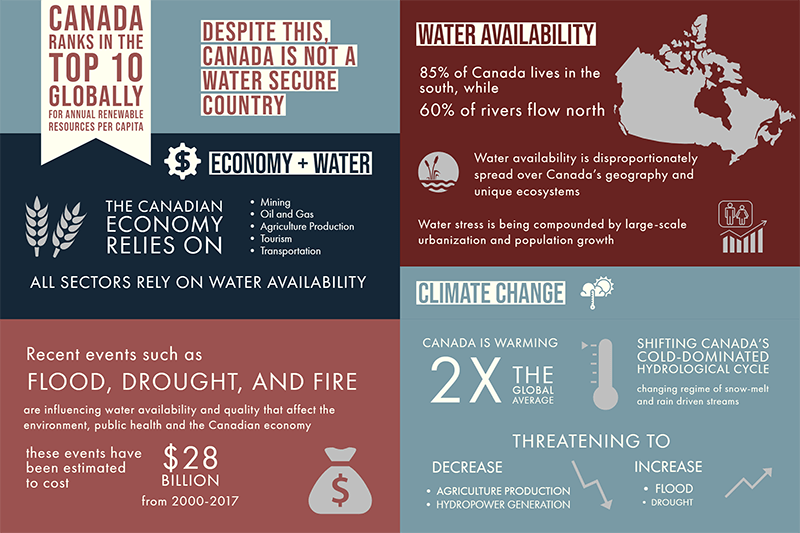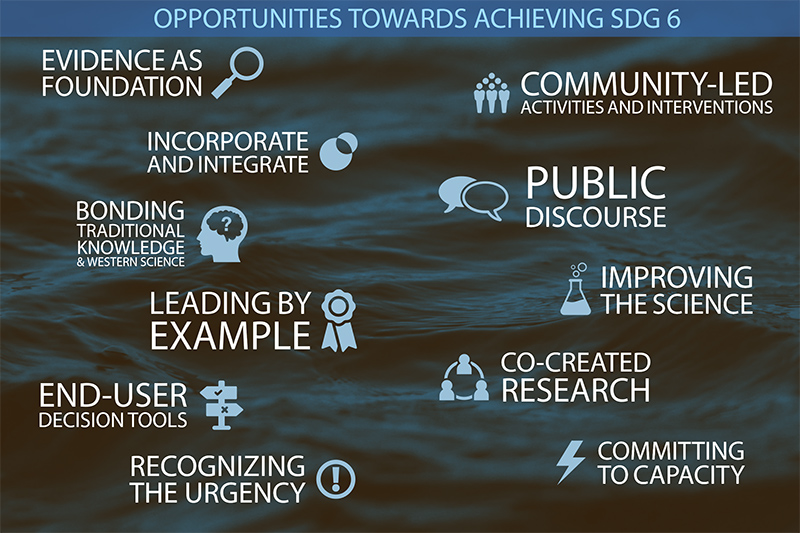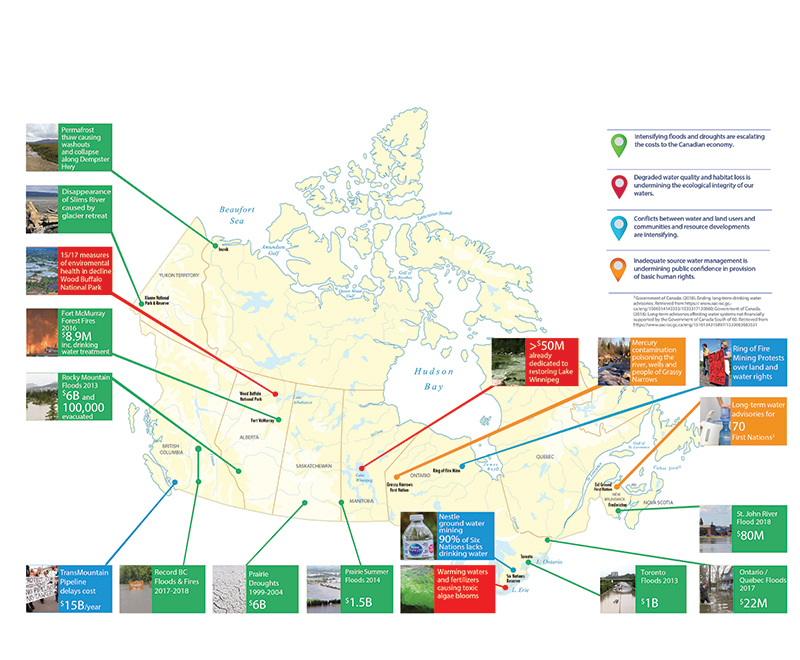The imbalances between economic growth and environmental integrity in our world, the existential threats manifesting through our changing climate, and the inequities that are exacerbated as a result, create the fundamental impetus for achieving the Sustainable Development Goals (SDGs) in Canada as well as the rest of the world. Collectively, these Sustainable Development Goals represent a roadmap towards a more resilient, just, and equitable society. This is why Canada has an opportunity and an obligation to not only get its own house in order, but also to provide leadership for the rest of the world. Water, and water diplomacy, represents a unique opportunity in this regard, building off the legacies of being a peace-keeping and water rich nation combined with world-leading water technologies, modern water industry and service delivery, and transformative water research across all water domains.
Through a commitment to good, responsible, and equitable management of its waters based on strong science, evidence, and Traditional Knowledge, Canada can improve domestic water management, achieve all targets under SDG 6 (the water goal), and claim a prominent global leadership role for all water-related SDGs. This will require changes in order to optimally harness and expand the existing strengths of our water sector. The following report describes a number of opportunities for achieving SDG 6.
Executive Summary
Achievement of Goal 6 is central to the achievement of the Sustainable Development Agenda
The global water cycle literally floods the earth on a seasonal basis. Global warming and subsequent climate change is affecting this seasonal redistribution as well as the form in which water falls from the sky – as rain, snow, or ice. The world is aware that water can increasingly be loved or loathed: it is critical for existence of life and central to our quality of life, while also being responsible for poor health and death from waterborne diseases. Its absence causes droughts, and too much in too short a time causes floods. Water is a cornerstone of economic growth, essential for energy production, and equally as important for ecosystems.
More frequent extreme weather events associated with too much or too little water have become threat-multipliers that are undermining social, economic, and political stability
In many instances, water security and climate stability can be seen as two sides of the same coin. Many of the impacts of climate disruption are, and will continue to be, expressed through effects on water.
Water, and the ways in which it is used, vary significantly between countries
Even in areas where it is abundant, degradation of water quality can ultimately mean that water resources are insufficient. Groundwater resources are particularly important and vulnerable. In many places in the world accelerating hydro-climatic changes are putting greater pressure on already deteriorating water quantity and quality. Climate change is not the only stressor on our water resources. Population growth, urbanization, land use changes including deforestation and degradation, changing diets, and expanding societal wealth also impact the quality and quantity of surface and groundwater resources.
Canada is not a water secure country
This is evidenced through recent catastrophic experiences with floods, drought, fires, and toxic algae blooms. The cost of floods and droughts for families, towns and cities, the insurance sector, businesses, agriculture, and ultimately the Federal Government, are skyrocketing. Moreover, Canadian lakes and rivers support diverse plant and animal habitats, forests, tourism, recreation, agriculture, transportation, and essential ecosystem services such as water purification. However, these are not easily valued and therefore not valued enough.
Canada’s water availability is disproportionately spread over a vast country spanning multiple ecozones, of which some, like the Canadian prairies, are semi-arid
Most fresh water drains to the north, while most people live in the south. The Canadian economy remains highly dependent on resource extraction, processing and transportation of oil and gas, ore, and pulp and paper, as well as intensive agriculture for crop and livestock production. All of these sectors are both heavily reliant on water availability, and have costs to the natural environment and our water resources that are not always fully recognized or completely mitigated.
Climate change is exacerbating water insecurity in Canada
Temperature increases in Canada are among the highest in the world. This warming is already having a substantial impact on Canada’s cold-dominated hydrological cycle. Hydrologic shifts, especially between snowmelt- and rainfall-driven streams and rivers and subsequent changes in peak water flows have consequences for agricultural productivity, hydropower generation, and floods and droughts. Weather events are becoming more extreme, traditional animal territories are changing, and pathogen ranges are expanding.
Jurisdictional fragmentation, territoriality, and inequities make it difficult to generate and implement a common water management vision in Canada
Portfolios such as agriculture, health, water and wastewater treatment are shared between multiple agencies and levels of government, and water itself flows across municipal, provincial, territorial, and sometimes national boundaries. Inequities also exist with respect to who experiences the impacts of these challenges and who is most vulnerable to them. Indigenous communities, women and girls, and natural ecosystems are being left behind in pursuit of economic progress. In the absence of a coherent vision of itself at its future sustainable best, Canada as a nation remains mired in divisiveness on matters of energy policy, resource development, and action on climate change.
There is considerable opportunity for Canada to coordinate the activities of its water sector
Through the example of good and responsible management of its waters, based on strong science and evidence, Canada can improve its own water management and play a prominent leadership role in meeting water-related targets of the Sustainable Development Agenda. Opportunities exist through leadership, example, and knowledge mobilization. Canada possesses a modern water industry, world-leading water technologies, professionally managed water service provision, and world-class transformative water research. The strengths of our water sector, however, have not been optimally harnessed and fully orchestrated for future national interest. Water cooperation, in particular, is poised to become a major instrument that can be used to prevent conflict while at the same time strengthening international stability and promoting peace.
Major gaps still exist if we are to meet the ambitious yet necessary Goals of the 2030 Agenda
Based on an analysis of reports, syntheses, and activities to date, previous recommendations, the SDG targets, and the challenges associated with meeting and measuring the SDGs nationally and internationally from a variety of sources, we offer recommendations for action in research, practice, and leadership. This report is intended as a blueprint for more coordination between research, policy, and practice between Canadian water researchers, the Canadian government, and other initiatives around the world that will intentionally fill the gaps identified as necessary to achieve a water future for the world we want. There are huge opportunities for Canada on the national and global stage in these areas. Given the right business model and access to support and resources, there is significant capacity within the Canadian water sector to deliver water technology, management, capacity, and predictive tools to emerging markets, particularly in developing countries, to accelerate greatly needed sustainable water resources management.
There is an urgent need to ensure the sustainability of natural bio-diversity-based Earth system function
Presently, there is a huge and growing gap between our understanding of the problems and implementation and practice. These gaps can be bridged by recognition of the link between water, peace, security, and human and planetary health and the SDGs can be a catalyst whereby we organize our intentions and our actions to get there. This report synthesises current undertakings, gaps, and opportunities through research, practice, and leadership to shape sustainability starting with our water future.
There is huge opportunity for university research and leadership to contribute to this water future
Research networks should continue to remind all of the risks and threats posed to future stability by poverty, inequality, injustice, failed governance, climate change, and the massive involuntary human migration that are already beginning to follow in their collective wake. Ideally, however, universities should go beyond just talking about the SDGs and their importance, as they are largely doing now. They are uniquely poised to be showing the country and the world what the SDGs mean and how to implement them. The challenges, as always, lie in generating transformative and sustainable change that is more than the sum of individual programs, projects, and activities, even when they have scientific value in and of themselves. As such, a commitment to leadership is essential to realize these actions and to leverage them to become greater than the sum of their parts.
Recommendations
Major gaps still exist if we are to meet the ambitious yet necessary Goals of the 2030 Agenda
Based on an analysis of reports, syntheses, and activities to date, previous recommendations, the SDG targets, and the challenges associated with meeting and measuring the SDGs nationally and internationally from a variety of sources, we offer recommendations for action in research, practice, and leadership.
- Establish nested monitoring programs at local, basin, and regional (ecosystem) scales building on and integrating existing programs for a more comprehensive view of water conditions;
- Provide open access to publicly funded and collected water-related data sets and model outputs, particularly those produced through regulatory requirements;
- Develop “reduced complexity models” for multi-stakeholder management decision support;
- Develop climate-related sector-specific scenarios, especially in areas of human health, agriculture, water, energy (hydroelectric power), and disaster preparedness;
- Generate risk maps and health assessments that can inform climate change adaptation strategies and planning;
- Enhance resilience towards extreme weather events through soil and water management and community-led interventions;
- Develop indicators for assessing quality of participation and partnership, such as effectiveness, value, nature of engagement, and ability to deliver meaningful change;
- Develop user-friendly interfaces for integrated modelling platforms to support access to appropriate and timely information;
- Develop end-user tools and applications, co-designed with practitioners, especially those boundary organizations representing civil society and marginalized groups;
- Evaluate, document, and transfer emerging, innovative solutions;
- Commit to the use of evidence as the foundation for good (water) governance at all management scales;
- Embed the connection to water more explicitly in policies and strategies currently not focused on water, such as the International Feminist Agenda, and embed gender equity and health and well-being into water policies and strategies;
- Target the communication of knowledge through social media, public service announcements, print media, and other public interventions to change attitudes and behaviours towards enhancing water efficiency, water quality, climate change mitigation, and personal climate risk reduction;
- Harness existing capacity in Canadian water research programs, federal government agencies, and NGOs to publish a biennial State of the Water Report for Canada that incorporates health, water quantity and quality, drinking water and wastewater, economic sectors, and the environment.
- Governments at all levels must take seriously and adhere to international commitments, such as the SDGs, the Sendai Framework for disaster risk reduction, and the Paris Climate Agreement;
- Governments and academic institutions must lead by example and commit to tackling the underpinning causes of climate change and water management including adopting a carbon neutral footprint, and equity, diversity, and inclusion in their workforces, policies, programs, and data;
- Following the example of the Canadian Institutes for Health Research, collaboration is required to reform funding mechanisms to facilitate true and meaningful community and stakeholder partnerships, especially in terms of direct research funds and project leadership;
- Academic institutions must value and incorporate community engagement and knowledge mobilization metrics as part of the tenure and promotion process to facilitate professional incentivization of individual researchers in applied and participatory research;
- Likewise, researchers focused on applied problems and solutions must challenge themselves to look at their contributions within the context of the SDGs and climate change adaptation, mitigation, and resilience;
- Politicians and political parties must recognize the urgency behind climate change mitigation and adaptation and the essentialism of sustainable development, commit to evidence-informed decision-making, stand against post-factual information ("fake news"), and articulate these in their platforms; and,
- The Federal Government must modernize the Canada Water Act to enable a more coordinated, practical, and multijurisdictional response to the root causes driving Canada’s emerging climate and water crisis including federal leadership on the scientific, technical, and administrative capacity to measure, predict, and respond to water problems and opportunities and to engage in water diplomacy domestically and internationally.
Full Report
Download the full report and supplementary tables below.



